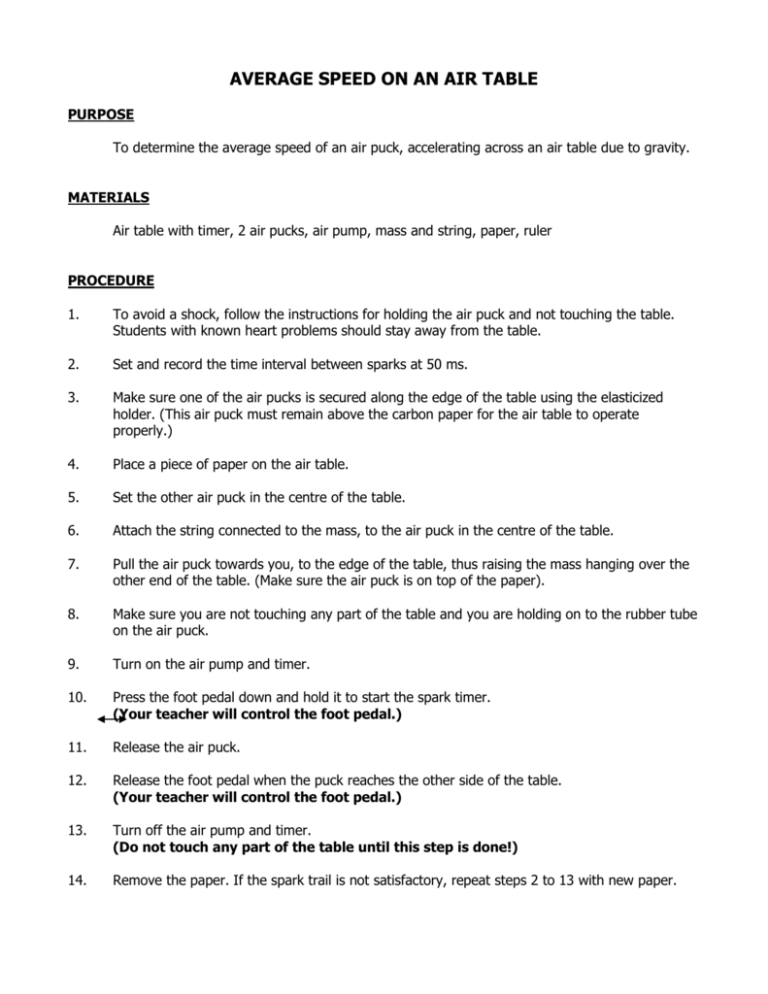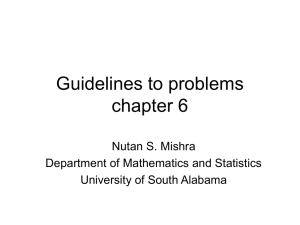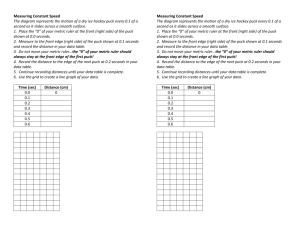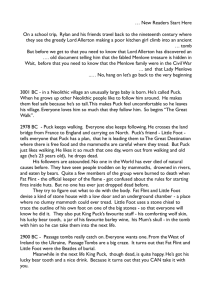AVERAGE SPEED ON AN AIR TABLE
advertisement

AVERAGE SPEED ON AN AIR TABLE PURPOSE To determine the average speed of an air puck, accelerating across an air table due to gravity. MATERIALS Air table with timer, 2 air pucks, air pump, mass and string, paper, ruler PROCEDURE 1. To avoid a shock, follow the instructions for holding the air puck and not touching the table. Students with known heart problems should stay away from the table. 2. Set and record the time interval between sparks at 50 ms. 3. Make sure one of the air pucks is secured along the edge of the table using the elasticized holder. (This air puck must remain above the carbon paper for the air table to operate properly.) 4. Place a piece of paper on the air table. 5. Set the other air puck in the centre of the table. 6. Attach the string connected to the mass, to the air puck in the centre of the table. 7. Pull the air puck towards you, to the edge of the table, thus raising the mass hanging over the other end of the table. (Make sure the air puck is on top of the paper). 8. Make sure you are not touching any part of the table and you are holding on to the rubber tube on the air puck. 9. Turn on the air pump and timer. 10. Press the foot pedal down and hold it to start the spark timer. (Your teacher will control the foot pedal.) 11. Release the air puck. 12. Release the foot pedal when the puck reaches the other side of the table. (Your teacher will control the foot pedal.) 13. Turn off the air pump and timer. (Do not touch any part of the table until this step is done!) 14. Remove the paper. If the spark trail is not satisfactory, repeat steps 2 to 13 with new paper. OBSERVATIONS 1. Create a table to record your data obtained from the air table data sheet. The headings for the table should include: DOT #, TOTAL TIME (ms), and TOTAL DISTANCE (mm). ANALYSIS 1. Examine the dots on your air table data sheet. Choose the first dot that appears on its own (not touching any of the other dots). This is the “START” dot or dot 0. Label it accordingly. 2. Measure the total distance from the centre of the “START” dot (dot 0) to the centre of each subsequent dot. Record the distances in your chart to the nearest mm. (Make sure that you always measure from the “START” dot). 3. Record the total elapsed time in your chart for each corresponding measurement. Remember that the space between each dot represents a time frame of 50 ms. 4. Draw a total distance (mm) versus total elapsed time (ms) graph using the data that you have collected. Connect the points on your graph with a smooth curve. Do not use a ruler! 5. What type of motion does this graph represent? 6. Using a ruler, draw a straight line from the first point on your graph to the last point. Calculate the slope of this line (record your answer to 3 significant digits). What does this slope represent? 7. Draw a diagram of what the dots generated by an air table would look like if the air puck was: a) moving at a slow constant speed b) decelerating Sample Data Sheet START d0 d1 d2 d3 d4 d5 ..... dn Measure all distances from the “START” dot Answer Sheet Mark out of 23 Title page: 1 mark; Problem – written out: 1 mark; Mat & Proc – referenced: 1 mark 5 marks for table: 1 mark – correct title; 1 mark – correct headings; 1 mark for correct data points (MUST INCLUDE – Dot 0, Time = 0 ms, Distance = 0 mm) Air Puck’s Movement Across an Air Table Due to Gravity Dot Number Time (ms) Distance (mm) 0 1 2 3 4 5 6 7 8 9 10 11 12 13 14 15 16 17 18 19 20 21 22 0.0 50.0 100.0 150.0 200.0 250.0 300.0 350.0 400.0 450.0 500.0 550.0 600.0 650.0 700.0 750.0 800.0 850.0 900.0 950.0 1000.0 1050.0 1100.0 0 7.0 15.0 25.0 35.0 47.0 61.0 77.0 95.0 114.0 134.0 156.0 180.0 204.0 231.0 256.0 286.0 316.0 349.0 382.0 417.0 453.0 490.0 #5: increasing speed (is a scalar unit – NOT velocity) 2 marks #6a: Point 1: (ti = 0 ms; di = 0 mm) and Point 2: (tf = 1100.0 ms; df = 490.0 mm) Vav = (tf – ti) ms / (df – di) mm = (1100.0 – 0) ms / (490.0 – 0) mm = 0.445 mm/ms (asked for in 3 significant digits) 2 marks: must include units and 3 significant digits #6b: average speed 2 marks (not velocity – is a scalar unit – NOT VECTOR) #7a: . . . . . . . . . . 1 mark: all dots evenly spaced . . . . . . . . . . . . . . . . . #7b: . . 1 mark: dots become closer together over time . . . . . .. Distance a Puck Travels on an Air Table Due to Gravity 500.0 450.0 400.0 Distance (mm) 350.0 300.0 250.0 200.0 150.0 100.0 50.0 0.0 0.0 200.0 400.0 600.0 Time (ms) 6 marks for Graph: 1 1 1 2 1 mark for correct title; mark for correct x axis label and units mark for correct y axis label and units marks for data points and best line drawn through points mark for line drawn from 1st to last point 1 mark for Conclusion 800.0 1000.0 1200.0








